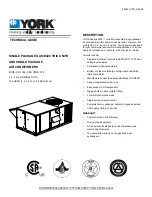
25
920-087-06
Basic Troubleshooting Techniques
Being familiar with the sequence of operation on Standard Controlled Operating Units or the operation of the Remote Thermostat
Controlled Units is important. The following questions and answers may help to identify performance problems.
Maintenance and Inspection Troubleshooting Guide
System is not serviced or inspected
regularly (semiannually or annually).
Air
fi
lters are not cleaned regularly and
become blocked with particles.
Condenser coil not maintained properly
(blocked with particles).
Evaporator coil not maintained properly
(blocked with particles).
Components that show signs of fatigue
- not replaced.
Condensate drains and drain lines not
maintained.
Can result in premature component failures, poor performance and
increased operating costs.
May result in poor cooling, icing and water problems as well as component
failures and increased operating costs.
May result in poor cooling, component failures and increased costs.
May result in poor cooling, icing and water problems, and increased
operating costs.
May result in multiple service calls, poor performance and increased
operating costs.
May result in water and odor problems.
CAUSE
RESULT
Environmental Effects - Cooling Mode
Is unit sized to room size area and heat load demand?
The number of people in the room, number of electrical devices,
solar gains, etc. are all variable items that can affect proper
sizing of the unit. Friedrich recommends that you consult with
an applications engineer for proper sizing.
Is the outdoor temperature 60°F or below?
The unit is designed for outdoor temperatures above 60°F.
Is the indoor temperature 80°F or above?
Ambient indoor temperatures of 80°F or above will take a longer
period of run time to cool down the area. Long run times may
indicate that the unit is undersized.
Is indoor humidity high?
This condition will cause the unit to operate longer to remove
humidity before noticing any cooling effect.
Has the heat load been increased by additional devices such
as computer equipment, or has the room area been increased
where the unit is located?
If conditions have changed, the unit may not be able to cool and
condition as effectively as previously planned.
Environmental Effects - Heating Mode
Is unit properly sized to room area and heat load demand?
The number of people in the room, number of electrical devices,
solar gains, etc. are all variable items that can affect proper
sizing of the unit. Friedrich recommends that you consult with
an applications engineer for proper sizing.
Is the outdoor temperature 70°F or above?
The unit is designed for outdoor temperatures below 70°F.
Is the indoor temperature 60°F or below? Ambient indoor
temperatures of 60°F or below will take a longer period of run
time to heat the area. Long run times may indicate that the unit
is undersized.
Has the room area been increased where the unit is located?
If the area where the unit is located has been increased, the unit
may not provide adequate heat.
Insuf
fi
cient Maintenance and Inspection
Installation errors are the most common cause of poor
performance. Please follow installation instructions carefully.
If other problems exist, see Maintenance and Inspection
Troubleshooting Guide below.





































